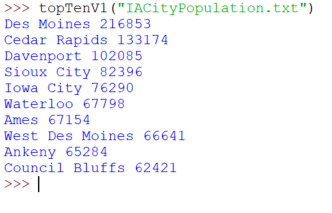You Do It #1: Creating a Top Ten List
"You Do It" activities are hands on activities where I ask you to read existing code, modify code to do something different, or consider the creation of brand new code. In some situations I will ask that everyone complete an activity. In other situations I will give you the option of how involved you get depending on what grade levels you teach and/or how interested you are in the topic.
Most "You Do It" activities are acceptable to complete on your own or with a partner.
All "You Do It" activities are non-graded activities (although I may ask you to submit something just to monitor your progress) created to have you engage with concepts that will be graded at some level in the competency demos. In that regard, they are there to enhance your learning. In most cases, it is the process that I am after rather than the results.
You can do this on your own or with a partner.
For Everyone
You Do It (YDI) Activity #1 - Top Ten List- Explaining Assignment #1 (Video, 5 minutes)
- Assume that we are trying to find and print the ten most populous cities in Iowa from the following data file.
- Population of Iowa Cities (Data File)
- You write some pseudocode
- Get out a piece of paper and a pencil
- Write down pseudocode (Wikipedia link) for at least one possible solution that you can come up with for the given task
- Do not watch the following video until you make an honest attempt at the previous YDI
- You compare your pseudocode to two possible pseudocode solutions
- Pseudocode Results Discussion [Video] (22 minutes)
- I strongly encourage you to watch this video even if the previous YDI made sense to you. Because I put a lot of emphasis onto WHY we want to write pseudocode that will be helpful as we move forward this semester.
- This video was actually made several years ago. But very little has changed!
- The Pseudocode I wrote in the Video
- Optional Challenge - You write the code.
- If you are:
- A High School Teacher
- Someone who really wants to review writing Python Code
- Someone who just found this whole problem interesting...
- I encourage you to attempt to convert your pseudocode (or one of the two I wrote with you in the video above) to actual, working, Python code
- Running it might look something like this:

- You read (and run) the code I wrote to solve this problem
- Here is code I wrote that produces two solutions that align with the pseudocode solutions from step #3
- Examine this code and consider
- How this code corresponds with the pseudocode we wrote in the videos.
- The skills you use when reading a new algorithm
- What code in there is completely new to you and how you would research it (Google it) to figure out what it does
- What you LEARNED looking at a completely new program